Do you want to grow lettuce in containers but don’t know where to begin?
Thankfully, lettuce is one of the easiest vegetables to grow in pots. They come in various shapes, colors, and flavors and are ready to harvest within a few weeks.
Best of all, they require very little attention. So long as the plants receive enough moisture and nutrients, they will grow.
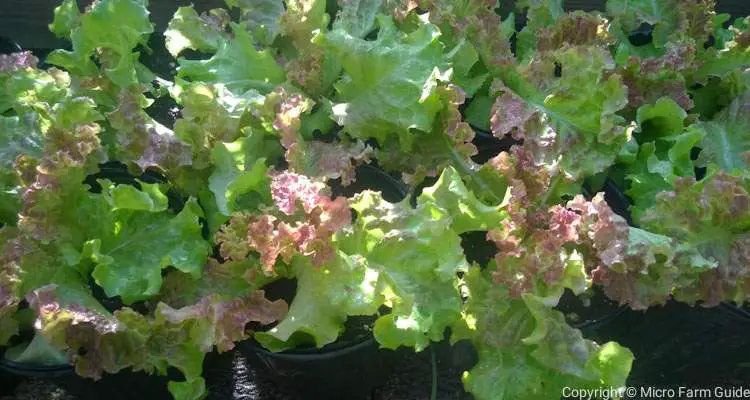
However, if you would like to get the best results from your container lettuces, there are some factors you should consider and tips you can use to ensure success.
In this easy-to-follow guide, you’ll learn a simple step-by-step process to grow lettuce in virtually any container using the variety of your choice. Let’s dive in!
Before We Get Started…
Here is a list of the tools and materials you will need for your container lettuce project. You might already have some of these items at home. I’ve included general notes with further details within each step.
| Items | Details |
| Lettuce Seeds | Choose The Variety Of Your Choice |
| Potting Soil Or Mix | Preferably A Well-Drained Organic Growing Media |
| Compost | Use Well-Rotted Or Bio-Active Compost |
| Hand Tools | Hand Fork, Knife, Hand Shovel, Micro-Tip Pruning Snips, etc. |
| Planting Containers | Ensure At Least 6” In Height |
| Watering Can | Preferably With Small or Narrow Rose |
| Tissue Paper | Bathroom Or Kitchen Tissue Will Work |
| Small Container With Lid | To Pre-Germinate Seeds |
| Seed Start Trays | Small Container With Drainage Hole |
| Organic Fertilizer | Preferably Liquid Organic Fertilizer |
| Spray Can Or Bottle | Small Spray Bottle of about 500 ml Will Work |
| Tweezers (Optional) | To Remove Insects If Necessary |
Now that you know what you’ll need, note the items you already have, and let’s move on to the first step.
Step 1: Choose A Well-Lit, Easily Accessed Location
Lettuce is a cool-weather crop that enjoys full sunlight but is well-adapted to growing in partial shade and other dappled light conditions.
Ideally, you should choose a well-lit, ventilated location that receives 6 to 8 hours of sunlight daily. For example, a sunward-facing balcony, window sill, staircase, driveway, yard, or rooftop.
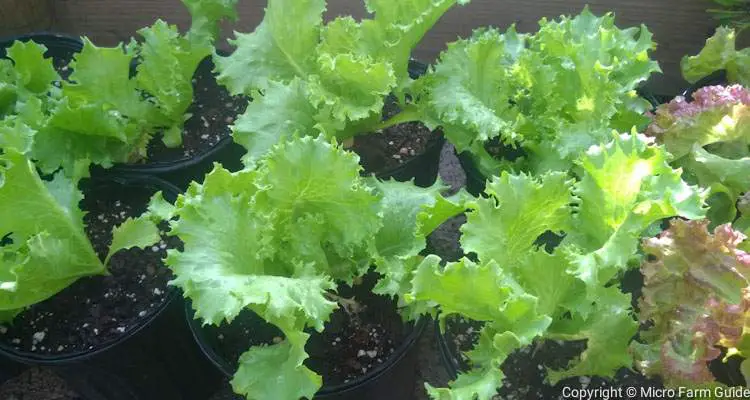
However, you can grow container lettuce indoors under grow lights or in naturally-lit rooms. The leaves of the lettuce will be visibly different, depending on the variety. Still, the plant itself will grow to maturity.
If you live in scorching climates, you might consider installing a shade structure above your crops to reduce heat stress during the day. You can simply suspend a 50% shade cloth above the growing area. It doesn’t have to be fancy.
Ensure that your chosen spot is easy to access by foot or mobility device if necessary. It should be close to a water source and preferably within your kitchen’s view. Remember, “out of sight, out of mind.”
See Also: How To Grow Tasty Lettuce (Even If It’s Hot Outside)
Step 2: Select The Best Variety Of Lettuce For Your Area
There are 5 distinct types of lettuce, the most popular of which are Iceberg and Romaine. However, several varieties are worth trying, each with different flavors, textures, and growing requirements, all of which increase in containers.
Here are some examples of the different types of lettuce. Even though lettuce prefers cool temperatures, I have been able to grow some varieties in tropical temperatures above 86°F.
| Type | Varieties |
| Crisphead | Iceberg, Minetto, Ithaca |
| Green Leaf | Black-seeded Simpson |
| Red Leaf | Red Rapid, Red Sails |
| Romaine | Paris Island, Cimmaron |
| Stem | Celtuce |
If you have limited space, a salad mix of the leafy vegetable can present you with an exciting blend of flavors and textures. These blends are usually grown intensely and harvested for their tender young leaves.
Due to their heat tolerance, we tend to grow Minetto and Red Rapid lettuce varieties here in the tropics. However, I can experiment with numerous combinations thanks to container gardening, moving the pots to more suitable locations if necessary.
Step 3: Choose the Best Containers For a Variety Of Lettuce
Lettuce is a shallow-rooted plant, which grows readily in most containers, providing it has enough moisture and space for the roots to spread horizontally.
Ideally, choose a container at least 6″ deep, with suitable drainage holes at the bottom. It can be made from any food-safe container, including recycled materials. However, you must pay close attention to terracotta pots since they tend to dry out quickly.
To grow lettuce indoors, you can use self-watering planters or, at the very least, place the containers in a spill tray or plant saucer. This container also comes in handy if you have a busy schedule and want to ensure your plants are well hydrated.
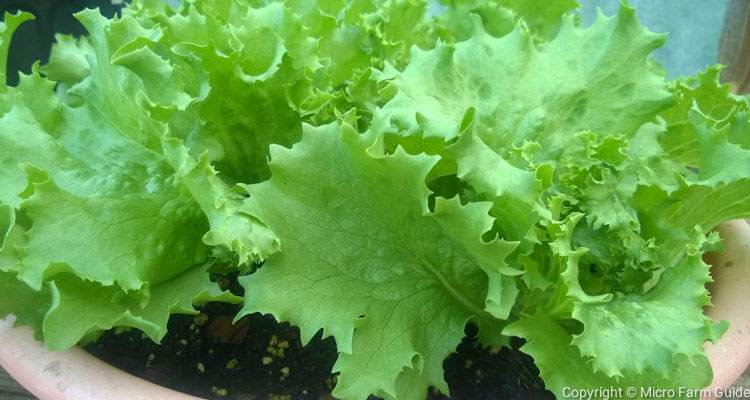
Window planters and boxes work great if you have a balcony or patio. They are aesthetically pleasing and provide the plants’ roots with the space and interaction they need to thrive.
If you are in a pinch, you can also try cardboard boxes, plastic bottles, and grow bags. While these work well, you must constantly replace them as they break down or become brittle. Nevertheless, they are great options if you’re on a tight budget.
Step 4: Prepare Well-Drained Potting Soil Or Growing Media
Lettuce comprises about 90% water and requires a constant moisture supply to grow healthy, tasty leaves. However, they are prone to root rot if left in stagnant water or soggy soil.
As a result, it is essential to use a well-drained, growing media that can retain enough moisture without becoming soggy. You can choose to purchase a ready-made blend such as a pro mix or organic potting soil.
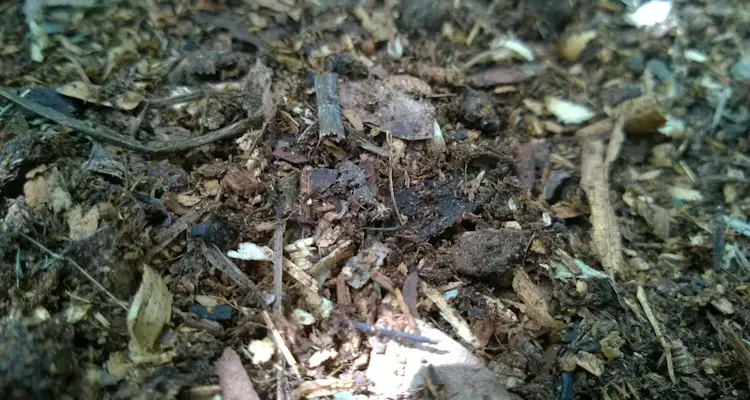
Alternatively, you can create your custom blend by combining compost, perlite, peat moss, or coco coir. However, these materials are costly in some countries. As a result, many people use garden soil, compost, and river sand to make an amazingly fertile media.
The main idea is to use or create a growing media that will allow the lettuce roots to move freely within the container and provide moisture when needed.
Initially, I would recommend purchasing the best organic potting mix you can afford at the time. Then gradually build and improve on it with each use. Ultimately, you will create infinitely better soil than any you can purchase.
Step 5: Sow Lettuce Seeds Using Tissue Method
Lettuce seeds are easy to germinate, provided they have enough moisture and temperatures between 70°F and 80°F. As a result, you can sow seeds directly into containers during weather times of the year. Still, the germination rate decreases quite a bit once temperatures rise above 90°F.
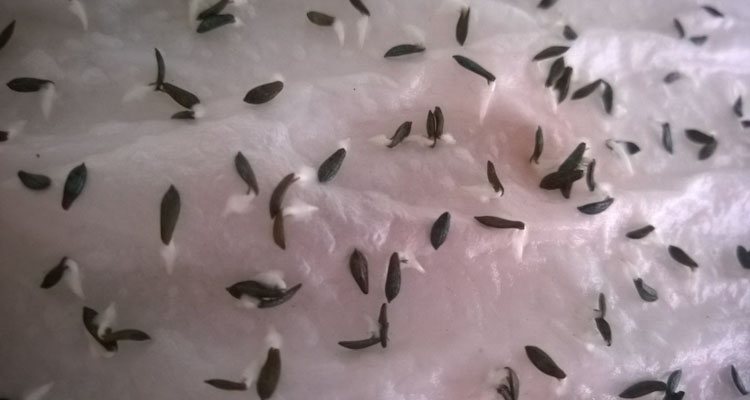
To increase your chances of success, you can use the Tissue Method, which basically pre-germinates the seeds in a more favorable environment before sowing. To do this:
- Place a sheet of tissue into a small container.
- Sprinkle some lettuce seeds onto the tissue.
- Moisten the tissue and seeds with water using a small spray bottle.
- Cover the container and place it in a cool, dark area.
Note: Most lettuce seeds will start to sprout within 24 hours using the tissue method. At which time, you can plant it directly into the containers. However, I prefer to sow them into seedling trays with individual cells.
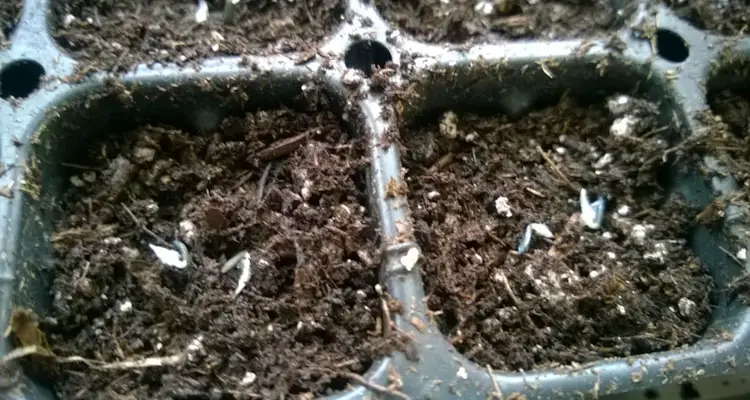
- Fill seedling trays with moistened potting mix or seed start mix.
- Remove excess material and tap the bottom of the tray onto a table. The potting mix will drop about ¼ inch. Fill to the mark if necessary.
- Place 2 sprouted seeds into each cell and cover with potting mix. Press gently and remove excess soil.
- Place trays into a container filled with about an inch of water, and let it wick into the potting mix.
- Remove from water, cover with a piece of cardboard, and place into a cool dark area until they germinate.
Seedlings usually start to emerge in two to three days. Monitor them daily to remove them from the shaded location at the first sign of germination.
Step 6: Care and Transplant Seedlings
Lettuce seedlings usually take between 21 to 28 days before they are ready to transplant into your containers. Treating them during this time can give them a considerable head start.
You should ensure that seedlings receive water only when necessary. Initially, you’ll have to water once every few days. However, if you need to water more than once daily, you should consider transplanting to a larger container.
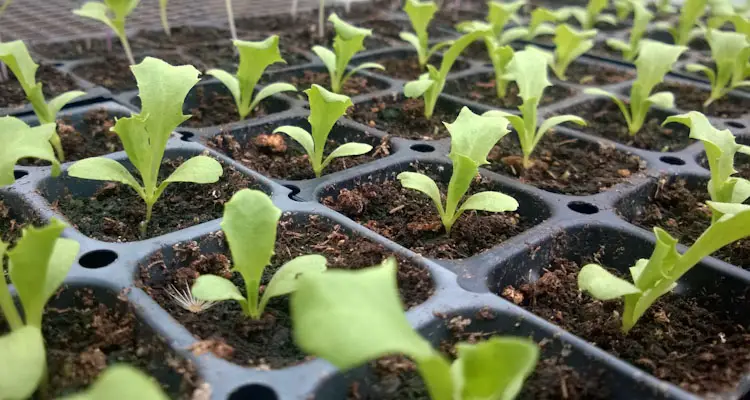
Thin seedlings after they grow to about 1” tall. You can do this by removing the weaker seedlings using micro-tip pruning snips. Please try to avoid disturbing the plant’s roots if possible.
Contrary to its appearance, lettuce is a heavy feeder and requires mainly nitrogen to facilitate rapid growth. However, they also need other minerals and nutrients to ensure proper function and cell formation.
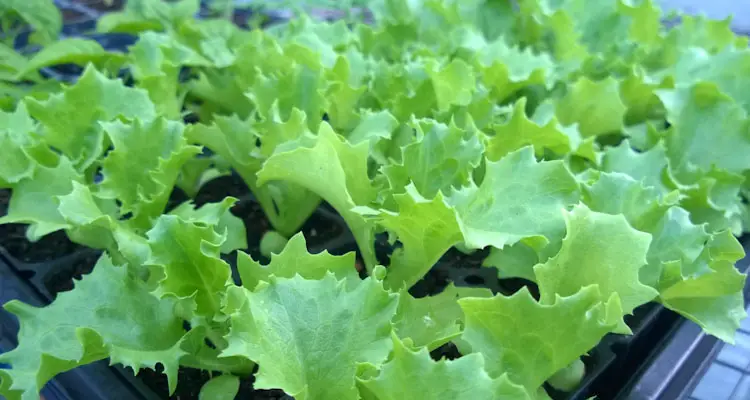
As a result, you will need to provide them with enough nutrients and minerals. This can be done by adding compost or slow-release organic fertilizer to the pot as a surface dressing. Water plants weekly with diluted organic fertilizer, starting after they produce their true leaves.
You can use any water-soluble fertilizer of your choice. However, I would suggest using organic liquid fertilizer, preferably in conjunction with a microorganism solution, to ensure that the nutrients are readily available for the plants.
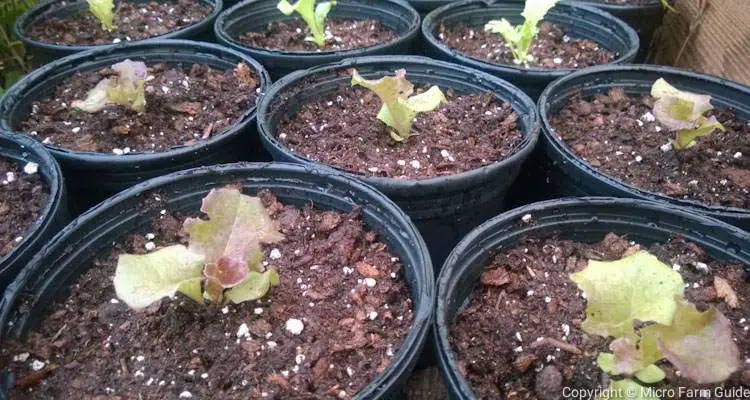
You can make your own fertilizer solutions at home by following the instructions in the articles below:
- How To Make JADAM Liquid Fertilizer (Quick And Easy)
- How To Make JADAM Microorganisms Solution (Step-By-Step)
However, you can read The Nutritive Cycle Theory for a more detailed explanation of the plants’ needs at various growth stages. I usually use the sample recipes suggested in the article, diluting the solutions a bit more for use in container gardening.
Step 7: Harvest and Store Lettuce Leaves And Heads
Lettuce grows fast and is generally ready for harvest within 3 to 6 weeks after transplanting. You should harvest lettuce early in the morning before they are exposed to the sun’s heat.
You can start harvesting leaf-type lettuce about 3 weeks after transplanting when they are about 6 inches long. Gently tear them out from the stem by pressing down and pulling across. In cool climates, leaf lettuce can be harvested every week until they are ready to flower.
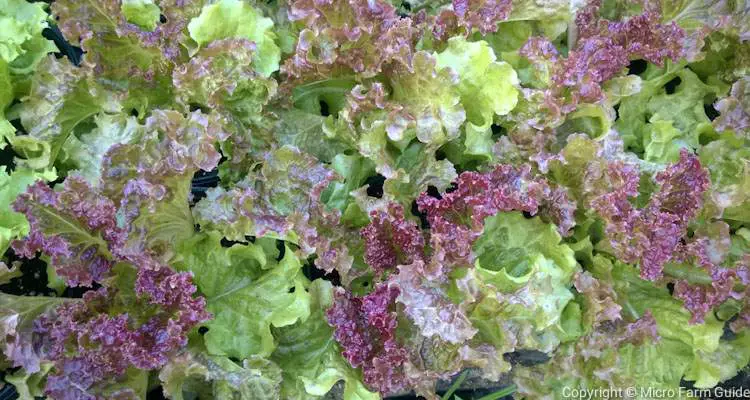
Some lettuce has the unique ability to be able to regrow rapidly after being trimmed. These are referred to as “cut and come again” and are harvested as the nickname suggests. Cut the leaves off this lettuce and allow them to regrow and repeat.
Harvest head or folding lettuce about 4 to 6 weeks after transplanting. You should notice a loosely formed head surrounded by leaves, both of which are edible. However, you will have to discard the older leaves from the outside.
Once harvested, you should clean and wash the lettuce leaves and heads in cool water, removing dirt and damaged leaves. Then air dry, using a fan, if possible, to ensure they remain cool. Place them into a plastic bag, and tie them in the crisper section of the refrigerator.
Note: if adequately cleaned, packaged, and stored, lettuce will remain fresh for two to three weeks. I’ve had customers report that their package of lettuce still looked fresh almost a month later, but I believe that’s more of an exception than a norm.
Step 8: Compost Damaged And Discolored Leaves
You will get damaged and discolored leaves regardless of how you treat your lettuce plants. These leaves are rich sources of nutrients, which you can use to feed your plants. So please do not discard them in the trash. Compost them instead.
There are many composting methods for you to choose from based on your location and available space. However, ideally, you should choose one that is odorless and easy to handle.
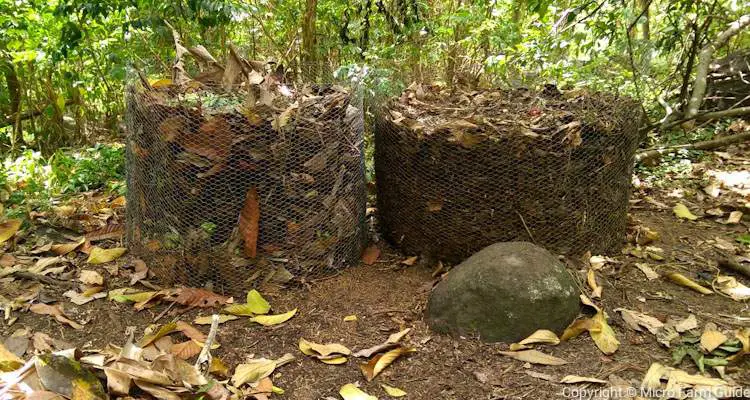
I would recommend the Bokashi composting method for anyone getting started with container gardening. The system comes in a convenient kit, is relatively odorless, and can literally compost anything, including meat and dairy.
Alternatively, you can add the leaves to a compost pile or bucket or create a liquid fertilizer using the JADAM method I mentioned above. You can also feed the leaves to smaller creatures such as chickens, rabbits, and worms.
Ideally, you will want to use a combination as your garden, knowledge, and experience increase. The main idea is to not throw away such a valuable resource.
Final Thoughts
Lettuce’s shallow roots and rapid growth make it the easiest vegetable to grow in containers.
However, you must ensure that your variety is well-adapted to your climate or provide the necessary protection and growing conditions to prevent bolting. Thankfully, this can be achieved with simple shade cloth and proper ventilation.
The secret to success with growing lettuce in the container is to select the best suitable variety for your climate. Then, ensure it receives adequate moisture, nutrients, and horizontal space for its roots to spread.
Related Questions
Can You Grow Lettuce In 4” Pots?
Yes, you can grow lettuce in 4” pots. However, you will have to pay more attention to watering and drainage since lettuce requires constant moisture but does not like soggy soil. Also, large plants will dry out the growing media faster than deeper ones.
References
NC State Extension. Pests Of Lettuce. content.ces.ncsu.edu. July 2022
Ministry Of Agriculture. How To Grow Lettuce. [PDF]. Accessed July 2022
Seeds Of Diversity. Saving Lettuce Seeds. [PDF] Accessed July 2022
The University Of Illinois Extension. Lettuce. web.extension.illinois.edu. July 2022
